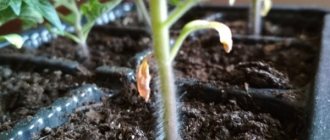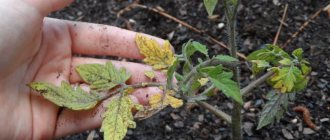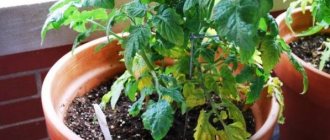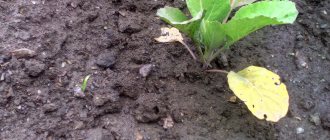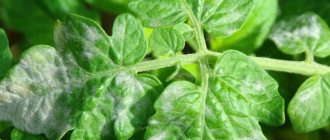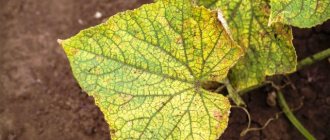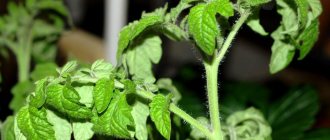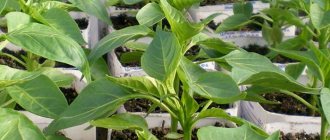Why and how do seedlings get sick?
To avoid possible diseases of seedlings, it is worth thinking about the quality of the soil in which your tomatoes will grow. It should not only be rich in essential substances and microelements, but also not contain anything unnecessary, for example, spores of fungal infections. To do this you need:
- use purified purchased soil;
- When using homemade soil, it should be thoroughly sterilized, for example, by pouring hot (about 80 °C) water or a bright pink manganese solution the day before planting.
Special soil for seedlings is sold in agricultural stores
You should also be attentive to the plant seeds themselves. To do this you need:
- choose trusted manufacturers;
- give preference to zoned varieties;
- follow the rules for storing seed.
This will ensure greater reliability of plants and their resistance to all kinds of external environmental factors.
Before planting tomatoes, the seeds must be treated:
- soak the seeds in a 3% saline solution to screen out the hollows;
- manually remove small and damaged seeds;
- treat the seeds with a 5% solution of potassium permanganate for disinfection;
- harden the seeds by placing them during germination for 18–20 hours at a temperature of about 0 °C.
It is also necessary to observe the correct conditions for keeping seedlings:
- maintain the temperature within 18–23 °C;
- control specific air humidity at 60–65%;
- carry out timely watering of plants;
- provide them with sufficient (about 14 hours) daylight hours.
Adult tomato seedlings have an even trunk and completely green leaves without spots
Once properly planted, be attentive to the development of the plants, especially if it involves unusual color or shape of leaves or stems.
How can tomato seedlings get sick?
All diseases of tomato seedlings can be divided into fungal, viral and bacterial. Plants can suffer due to improper care, pests and lack of nutrients. No single precaution can completely guarantee the safety of seedlings, so you should always be attentive to the condition of the plants. Seedling diseases occur not only during mass greenhouse planting, but also during small home plantings.
If tomatoes have slow growth, the plants look weak and exhausted - most likely the reason lies in problems with care. If there are any insects in the tomatoes (even ordinary fruit flies), it is worth carrying out disinfestation.
White spots on the leaves are a sign of the disease - septoria
Table: classification of diseases of tomato seedlings
| Type of disease | ||
| Fungal diseases | Viral diseases | Bacterial diseases |
| Blackleg; septoria (white spotting); fusarium wilt; late blight; gray rot; white rot; black rot. | Mosaic of tomatoes; streak (roughness); aspermia (spermlessness). | Black spot; brown spot. |
Preventing yellowing of tomatoes
Yellowing of leaves can seriously weaken tomato seedlings and slow down development, which negatively affects yields at the end of the season.
Preventive measures to prevent yellowing of the foliage of young tomatoes include:
- compliance with the crop's growing requirements - ensure good lighting, optimal temperature, air humidity and regular but moderate watering;
- high-quality soil preparation before sowing and picking - adding loosening components, maintaining acidity close to neutral;
- timely balanced feeding of seedlings;
- dressing seeds and substrate before sowing and transplanting with fungicides, for example, Fundazol (1 g of the drug is diluted in 1 liter of water);
- preparing suitable sized planting containers with drainage holes;
- Watering tomatoes only with warm, settled water.
It is much easier to prevent the appearance of yellowness on tomato foliage than to later look for the cause of its occurrence and take measures to save the seedlings. Prevention in this case is very important.
Diagnosis of lesions
It is extremely important to diagnose the problem in time in order to take the necessary actions to save the plant. At an early age, plants are most susceptible to various problems, as they spend their energy on growth and rooting. Therefore, you need to especially carefully monitor their condition. The table below will help you determine the cause of your plant's deviation from the norm so that you can then find a solution to the problem.
Table: identifying seedling problems by appearance
| Symptoms | Possible causes of the disease | ||
| Care errors | Seedling diseases | Tomato pests | |
| The seedlings turn yellow (including leaves). | Lack of nitrogen; lack of potassium; insufficient magnesium content; iron deficiency; low amount of sulfur; lack of manganese. | Fusarium wilt; mosaic of tomatoes; brown spot. | Melon aphid. |
| The leaves of the seedlings dry out. | Potassium deficiency; lack of calcium; | Streak. | — |
| The seedlings are not growing well. | Lack of nitrogen; low amount of phosphorus; lack of sulfur; low temperatures; lack of moisture; excess fertilizer. | Aspermia; black spot. | — |
| Plants fall. | Insufficient daylight hours; high temperatures. | Blackleg. | — |
| The leaves of the seedlings curl. | Lack of calcium; lack of boron; small amount of copper. | Fusarium wilt. | Melon aphid. |
| The stem of the plant turns black. | — | Blackleg; black rot. | — |
| Tomato leaves turn blue. | Lack of phosphorus; lack of copper. | — | — |
| The seedlings are withering. | Excess moisture. | Blackleg; fusarium blight. | — |
| Dark spots on seedlings. | — | Late blight; gray rot; black rot; streak; black spot. | — |
| Light spots on seedlings. | — | Septoria; white rot. | Thrips; whitefly |
How to treat diseases
Let's consider in turn all possible fungal, bacterial and viral diseases that affect tomato seedlings, and also figure out how to prevent the development of diseases or, if possible, cure already infected plants.
Fungal diseases
Most often, seedlings are affected by fungal diseases. They can appear from insufficiently cultivated soil or directly on plant seeds. High humidity in the room, improper watering with moisture getting on the sprouts, as well as insufficient drainage of planting containers and stagnant water contribute to the development of fungi, as they provide them with the most comfortable environment for reproduction.
Improper care of seedlings causes fungal diseases
Blackleg
This disease is very common and can appear already at the seedling stage. Otherwise it is called root rot or rhizoctonia. The fungus attacks the tomato close to the soil, causing the stem to darken and become thinner. When the fungus spreads throughout the stem, the sprout withers and falls. It is no longer possible to save this plant. The affected sprout must be removed, the soil should be shed with a 3% manganese solution, and healthy plants should be sprayed with Bordeaux mixture for prevention .
Please note that black stem in tomatoes especially often appears when the plants are not properly cared for and the environment is high in humidity.
It is impossible to save plants damaged by blackleg.
Septoria (white spot)
This fungal disease begins to affect the fruit from the lower leaves, which become covered with small light spots. Over time, the spots darken, acquiring a brown tint, and the disease itself rises higher throughout the plant.
Pests of seedlings
Insects for tomato seedlings are no less dangerous than diseases. It is very important to identify the pest in time and destroy it. It is worth saying that insects, of course, more often infect seedlings in a greenhouse than on the window sills of city apartments. Nevertheless, it is better to know the manifestations of these pests and be prepared for protective actions.
Thrips
These small insects are extremely difficult to distinguish on the surface of the leaf. Thrips begin to destroy tomatoes from the tops. After a few days, the foliage loses its aesthetic appearance and changes color to an extremely light shade. This pest is capable of multiplying quickly, doubling the number of individuals in less than a week. As a preventative measure, seedlings are sprayed with an aqueous infusion of garlic.
Preparation of garlic infusion:
- Chop the garlic.
- Dilute it with water at the rate of 1 tablespoon of mixture per 200–250 ml of water.
- Let the solution sit for 2–3 hours,
- Strain through cheesecloth or strainer.
You can spray the seedlings with garlic infusion using a spray bottle. If thrips have already appeared on the seedlings, they need to be treated with Karate, Actellik or Fitoverm.
Thrips are only 2 mm long
Whitefly
The whitefly is a small butterfly up to 3 mm long. It feeds on the sap of the plant and also lays a large number of larvae, which are visible as a characteristic white coating on the leaves of the seedlings. Sometimes this coating contains black specks, as this insect carries sooty fungus spores. Whiteflies reproduce quickly and can destroy an entire plant in two days. As such, there are no preventive measures against whiteflies, but butterflies and larvae are well destroyed by the drug Fosbecid or Aktara.
Why do tomato leaves turn yellow after transplanting?
After planting seedlings in the garden, it is important to monitor the progress of plant adaptation. Seedlings begin to be watered after transplantation on the 4th day. The leaves will not turn yellow if the soil is slightly moist.
When planting in the garden, it is important to maintain the integrity of the root system.
It is best to transport the seedlings together with a lump of earth. Then they will acclimatize faster and continue active growth.
It is important to plant seedlings in open ground when the temperature remains above 15 degrees. And if a sharp cold snap begins, the seedlings will have to be covered. This way you can protect the bushes from diseases and yellowing of leaves.
Death of seedlings for other reasons
Tomato seedlings do not always deteriorate due to certain external influences: insects or diseases. Sometimes plants simply lack the necessary microelements. Let's look at the most common problems with microelements in the soil:
- lack of nitrogen makes the plant trunk fragile, and the tomato leaves turn yellow or completely lose color;
- a lack of a substance such as phosphorus slows down the growth of the plant; tomatoes also turn their leaves bluish and drop them;
- a small amount of potassium leads to yellowing of the foliage, which then darkens, becomes deformed, dries out and falls off;
- with a lack of magnesium, yellow stripes can be seen along the veins of the leaves, sometimes the leaves completely turn yellow and die;
- a lack of iron turns the leaves of tomato seedlings light yellow, while the veins remain green;
- calcium deficiency can be identified by yellowed, shriveled and curled ends of young leaves;
- with a lack of boron in the soil, the plant becomes fragile, the upper shoots of the seedlings dry out and curl, the veins of the leaves lose color;
- lack of sulfur manifests itself in the paleness of the seedling, the stem becomes fragile and thin, the leaves lose color;
- with a lack of copper, the leaves of the seedlings acquire a bluish tint, turn white at the edges and curl;
- A lack of manganese causes leaves to turn yellow at the base and along the veins.
Try proven fertilizers:
